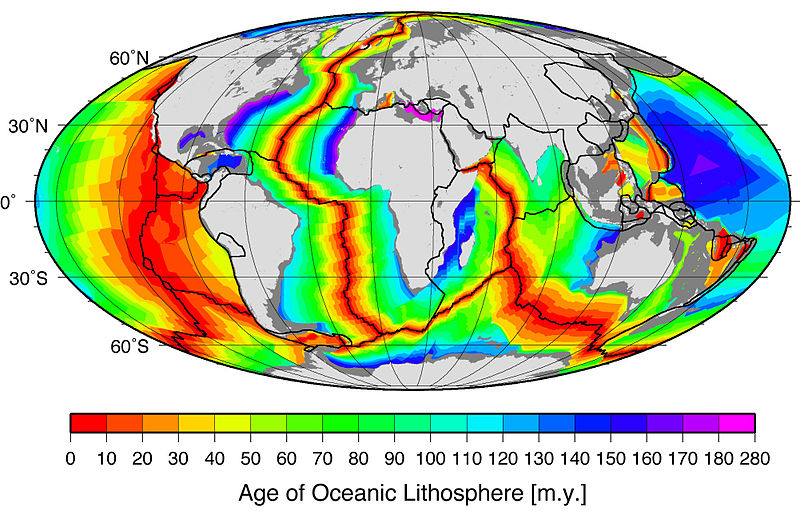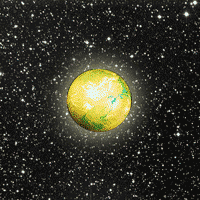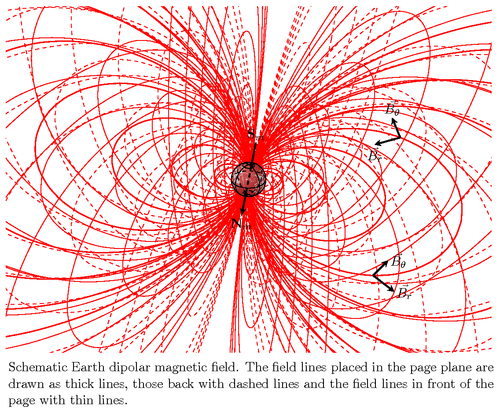The Mechanism for the Expanding Earth
For over a century, the hypothesis that the Earth has undergone expansion has been one of the most well-known proposals for the formation of the continents as we see them today in what has been known as the Expanding Earth Theory or Growing Earth Theory. This is largely due to the apparent ability for all the continents of Earth to fit together rather nicely, without oceans, on a smaller globe.
Further observational evidence frequently referenced by proponents of the Expanding Earth Theory is the age of oceanic crust:

Source
It is argued that if the time of the age of the oceanic crust is reversed, then the continents come back together in a smaller globe.
This hypothesis, though, has become looked at negatively since the theory of plate tectonics arrived on the scene. The main argument presented against the Expanding Earth Theory has been: what is the mechanism?
It's Not Expanding Now!
Another argument presented is the evidence that the Earth is not presently expanding.
Such studies of the change in the radius of the Earth are frequently referenced as the basis for why the Expanding Earth model is invalid.
The Earth Did Expand
These conclusions, though, assume that the rate of growth of the radius of Earth would have been constant and would have continued to present day. We are well aware of systems remaining a certain way until they rapidly undergo change and transform to a new steady-state. One such example of this would be the radioactive decay of an atom. Another would be the supernova of a star. Therefore, it is plausible that the Earth did expand but has reached a new steady-state where its expansion rate is approximately zero. Thereby, the observation regarding the current change in the radius of the Earth is not inherently incompatible with an Earth that has expanded.
"What Is the Mechanism?"
It is important to note that just because we do not know everything does not preclude a conclusion from being accurate. The mechanism argument has been thrown around as a proof that the Earth did not expand simply because an all-encompassing explanation for how it occurs was not fully understood.
The lack of a mechanism to explain the theory does not negate the observation that the continents of the globe can fit together quite well on a smaller radius body. In addition, it does not negate the evidence of the oceanic crust.
Imagine you entered a room and a ceramic lamp was on the floor, broken apart, lying near to a small table. Someone asks you, "how did this happen?" You respond, "it looks to have fallen." They say, "How did it fall?" You don't have an explanation for how it fell, but all signs point to the obvious: it fell. The same is the case for the proponents of the Expanding Earth Theory.
The Mechanism for the Expanding Earth
That is all great and good, but for the theory to become recognized as an actual description of what happened to Earth, it does need a mechanism. And this starts with physics.
First and foremost, the universe is infinite. This means that there are infinitely large and infinitely small particles in existence, relative to the particles we know of as "atoms". Smaller particles, like neutrinos passing through Earth, are capable of traveling through larger particles and pass through their center of gravity. When the body they are traveling through is rotating relative to its surroundings, this causes the flow pattern of these smaller particles to have a curved trajectory so that gravity can influence their pathing from a side angle. As a result, they travel in a Figure-8 orbital pattern. The summation of particles traveling in a Figure-8 orbital is what we see as an electromagnetic field. This is how gravity causes electromagnetism. For more information, read The Big Bang's Big Assumption.
Due to electromagnetic fields being the result of the flow of a sea of particles through the center of gravity, the center becomes an area of high density of these particles where they are more likely to interact and become larger systems. Atoms are created as a result of this process.
If the system is already in equilibrium, it will remain essentially the same. However, if the system went through a change, such as going from non-rotating (alike to Venus) to rotating (like Earth), then the creation of mass would be greater than the loss of mass and so the body would expand. As the rotation would also bulge the equator of the body, it would produce stress on the single land-mass that would be exacerbated by the increasing pressure due to the buildup of newly formed atoms. Lighter atoms, such as hydrogen and oxygen, would be more likely to form and then, due to the lower density of water, travel outward towards the crust.
Over time, when the pressure buildup was too large and the stress on the body reached a critical level, it would rupture and crack and release the built up newly formed mass to the exterior of the planet. This would flood the planet as the continents were pushed apart and new oceanic crust formed from where the cracks in the unified crust occurred, until enough oceanic crust was created to give space to house the volume of water released from within the Earth. As a result, continents and the oceans between them would be formed.
Over time, a new equilibrium would be reached as the planet would release more and more mass until it released as much mass as it was forming from its electromagnetic field, and this would lead to a reduced rate of expansion to the point where it would become relatively undetectable.
Everything is connected. If you'd like to learn more, check out my page here on Steemit.
Thanks for reading!
-Steve Scully

